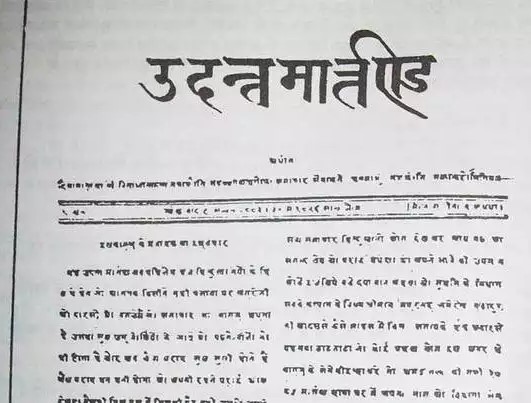Prof Mrinal Chatterjee
Four out of the top five largest circulated newspapers in India presently are in Hindi, with a combined circulation of over 14 crores. It all started on 30 May 1826 with the publication of Oodhund Martand, (or Udant Martand in some documents, which means rising sun), a weekly Hindi newspaper from Calcutta (now Kolkata). Incidentally it was the day of Narada Jayanti. Narada, a mythical wandering sage is widely considered to be the guru of the journalists.

Pandit Jugal Kishore Shukla (Jooghol Kishore Sookool- in some documents) edited and published it from Amar Talla Lane, Kolutola in the Bada Bazar area of Calcutta (now Kolkata) ‘in the interest of Hindustanis’. The print order for the first issue was 500. Udant Martand used a mix of Hindi dialects- Khari Boli and Braj Bhasa in Devnagari script. This weekly newspaper reached readers every week on Tuesday.

By the early 1820s, newspapers in few Indian languages had been published including Bengali, Urdu and Persian. Samachar Darpan, 1818 was the first Bengali newspaper followed by Jam-e-Jahan Numa in Urdu (27 March 1822) and Mirat-ul-Akhbar (12 April 1822) in Persian.
Jugal Kishore Shukla hailed from Kanpur, but made Calcutta his workplace. He was a lawyer. He wanted to talk about the rights of indigenous Indians in British ruled India. For this, he started publishing ‘Udanta Martand’. In his papers, he raised the issue of equality of status of the Indians vis a vis the Europeans. He also raised issues of social inequality, besides publishing local news and news from Hindi speaking areas.
However, the paper could not get many readers, as there were not many Hindi speaking and Devanagari script reading people in Kolkata and Eastern India. He tried to send the paper to Hindi speaking states in North India. In that time he could only send the newspapers by post. It became very costly and economically unviable because of the high postal rates.
Shukla requested the government to give some concession in postal rates so that newspapers could be sent to readers in Hindi speaking regions, but the British government did not agree to it. He requested postal fee exemption for eight newspapers to be posted to North India. That was also denied. Besides, no government department agreed to buy even a single copy of ‘Udanta Martand’.
Thus, mainly due to financial constraints, ‘Udanta Martand’ could not be published for a long time, and finally, on 4 December 1826, it stopped publication.
Years later, in 1850- Jugal Kishore Shukla made an attempt to start another paper called Samyadani Martand. But that also failed.
Udanta Martand as an individual newspaper failed to live long. However, it marked the beginning of journalism in Hindi.
(The author is Regional Director Indian Institute of Mass Communication, IIMC Dhenkanal. Views are personal)






















